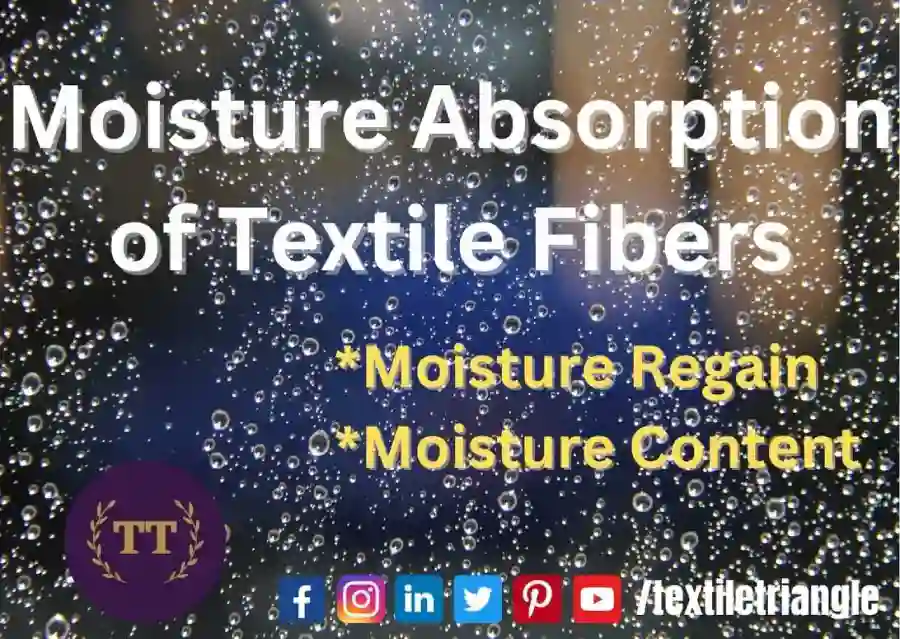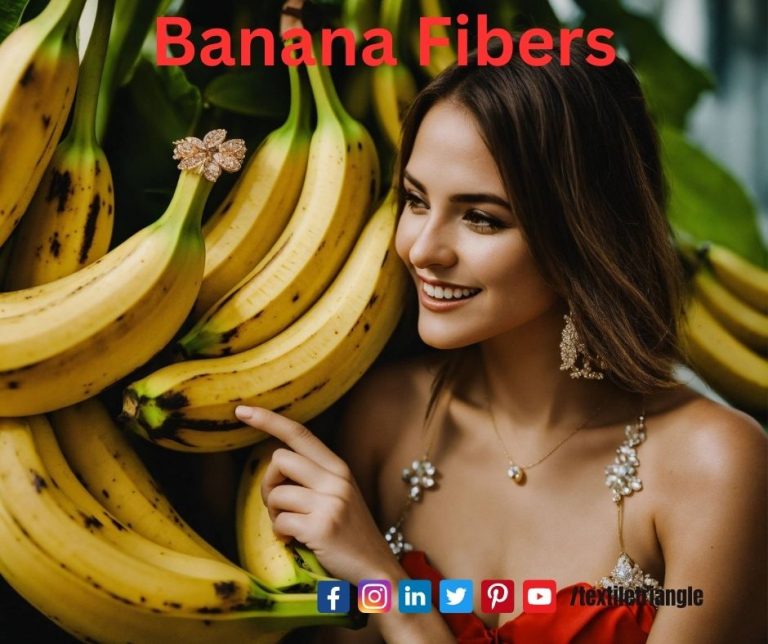Table of Contents
1. Introduction
Moisture absorption refers to the ability of fibers to take in and retain moisture from the surrounding environment. Different types of fibers have varying degrees of moisture absorption properties. Here are some key points about moisture absorption of fibers:
- Hygroscopic Nature: Many fibers, especially natural fibers such as cotton, linen, and hemp, possess hygroscopic properties. Hygroscopic fibers have the ability to attract and hold moisture molecules on their surfaces or within their structures due to their chemical composition and structure.
- Moisture Regain: Moisture regain is a measure of the amount of moisture a fiber can absorb when exposed to a specific relative humidity (RH) level. It is usually expressed as a percentage, representing the weight of the absorbed moisture relative to the dry weight of the fiber. Fibers with higher moisture regain values can absorb more moisture from the environment.
- Equilibrium Moisture Content: Fibers reach an equilibrium moisture content (EMC) when they have absorbed as much moisture as the surrounding environment can provide at a specific RH level. The EMC depends on factors such as fiber type, structure, and the prevailing humidity conditions. At equilibrium, the moisture content of the fiber remains relatively stable.
- Moisture Absorption Rate: Different fibers have varying rates of moisture absorption. Some fibers, like cotton, have relatively high absorption rates and can quickly take in moisture when exposed to humid conditions. Other fibers, such as wool, can absorb moisture at a slower rate but can hold a significant amount of moisture without feeling wet.
- Moisture Management: The ability of fibers to absorb and release moisture affects the comfort and performance of fabrics. Fibers that absorb moisture effectively can help wick away sweat or moisture from the body, keeping the wearer dry and comfortable. Moisture absorption properties also influence the breathability, drying time, and overall moisture management characteristics of fabrics.
It’s important to note that the moisture absorption properties of fibers can be influenced by various factors, including fiber composition, structure, processing methods, and environmental conditions such as temperature and humidity. Understanding the moisture absorption characteristics of different fibers is essential for selecting suitable materials for specific applications, such as sportswear, bedding, or upholstery.
Most of the fibres are hydroscopic and hydrophobic in nature,moisture absorbency divided whether the fabric is suitable for particular puspose.
- Moisture Regain
- Moisture Content
1. 1 Moisture Regain
It is defined as weight of water in a material expressed as a percentage of oven dry weight.
It is denoted by R.
R=W/D*100 Where,W=Weight of water and D=Oven dry weight
![]()
1.2 Moisture Content
It is defined as the weight of water in a material expressed as a percentage of total weight.
It is denoted by M.
M=W/(W+D)*100 Where, W=Weight of water and D=Oven dry weight
![]()
2. Relationship between Moisture Regain and Moisture Content
M=R/(1+R/100)
Where : M= Moisture Content, R= Moisture Regain
MR and MC values of various fibres:
| Fibre | M.C.% | M.R.% |
| Cotton | 7.34 | 8.5 |
| Silk | 9.91 | 11 |
| Wool | 13.8 | 11 |
| Viscose | 9.91 | 11 |
| Nylon | 3.1 | 4.5 |
| PET | 0 | 0.4 |
| Acetate | 0 | 6.0 |
| Acrylic | 0 | 1.5 |
| Flax | 10.4 | 12.4 |
| Hemp | 10.4 | 12.4 |
Effect of moisture on fibre properties
Moisture can have various effects on fiber properties, depending on the type of fiber and the extent of moisture exposure. Here are some common effects of moisture on fiber properties:
- Dimensional Changes: Moisture can cause fibers to swell or shrink. When fibers absorb moisture, they can swell, leading to an increase in their dimensions. Conversely, when fibers lose moisture, they can shrink, causing a decrease in their dimensions. These dimensional changes can affect the overall size and shape of textile materials.
- Strength and Elasticity: Moisture can impact the strength and elasticity of fibers. In some cases, moisture absorption can cause fibers to weaken, reducing their tensile strength. This weakening effect is more pronounced in certain fibers, such as natural fibers like cotton or viscose. Additionally, moisture can affect the elasticity of fibers, leading to changes in their stretch and recovery properties.
- Flexibility and Drape: Moisture can enhance the flexibility and drape of fibers. When fibers absorb moisture, they become more pliable and flexible, allowing them to conform to body movements or drape more smoothly. This effect can improve the comfort and aesthetics of fabrics.
- Electrical Conductivity: Moisture can increase the electrical conductivity of certain fibers. This effect is particularly notable in synthetic fibers like nylon or polyester. Moisture acts as a conductor, facilitating the flow of electric charges along the fiber surface. This property can be advantageous in applications where static electricity buildup needs to be minimized.
- Color and Appearance: Moisture can affect the color and appearance of fibers and fabrics. In some cases, moisture absorption can cause color changes or alterations in the appearance of dyes or prints. For example, certain dyes may bleed or migrate when exposed to moisture, resulting in color bleeding or fading.
- Microbial Growth: Excessive moisture can create an environment conducive to microbial growth. Moisture-laden fibers provide a suitable breeding ground for bacteria, fungi, and mold, which can lead to unpleasant odors, discoloration, and deterioration of the fiber structure.
It’s important to note that different fibers can respond differently to moisture, and the effects can vary based on factors such as fiber composition, structure, processing, and environmental conditions. Understanding and managing moisture content is crucial in maintaining the desired performance and appearance of fibers and textiles.
Moisture regain of cotton
Moisture regain refers to the ability of a fiber to absorb and retain moisture from the surrounding environment. In the case of cotton, moisture regain is a measure of how much moisture the cotton fiber can absorb when exposed to a specific relative humidity (RH) level.
The moisture regain of cotton is influenced by the hygroscopic nature of cellulose, the primary component of cotton fibers. Cellulose has hydrophilic properties, meaning it has a strong affinity for water molecules. This characteristic allows cotton to absorb moisture from the air and release it when the humidity decreases.
The moisture regain of cotton is typically expressed as a percentage. It represents the weight of moisture absorbed by the cotton fiber divided by the dry weight of the fiber, multiplied by 100. The specific moisture regain value can vary depending on factors such as the cotton variety, processing methods, and environmental conditions.
On average, cotton has a moisture regain of around 8% to 10%. This means that when exposed to a specific relative humidity, cotton fibers can absorb moisture equivalent to approximately 8% to 10% of their dry weight. For example, if you have 100 grams of dry cotton, it can absorb around 8 to 10 grams of moisture at a specific humidity level.
It’s important to note that the moisture regain of cotton is reversible. As the environmental humidity decreases, cotton fibers can release the absorbed moisture back into the air. This property contributes to the breathability and comfort of cotton fabrics, as it helps regulate moisture levels and maintain a dry and comfortable feel.
Frequently Asked Questions
What fiber absorbs moisture?
There are several types of fibers that have the ability to absorb moisture. Some common examples include:
Cotton: Cotton fibers have a high capacity for absorbing moisture. They can absorb up to 27 times their weight in water, making them highly effective in absorbing sweat and moisture from the body.
Bamboo: Bamboo fibers have natural moisture-wicking properties, allowing them to absorb moisture and keep the body dry. They are often used in clothing and bedding for their moisture-absorbing and breathable qualities.
Hemp: Hemp fibers are known for their moisture-absorbing properties. They can absorb and release moisture quickly, making them suitable for moisture-wicking fabrics.
Wool: Wool fibers have a unique structure that can absorb moisture without feeling wet. Wool can absorb up to 30% of its weight in moisture without feeling damp, making it effective in regulating body temperature and wicking away moisture.
Modal: Modal is a type of rayon fabric made from beech tree pulp. It has excellent moisture absorption properties, making it comfortable to wear and suitable for moisture-wicking applications.
Microfiber: Microfiber fabrics, often made from polyester or nylon, have fine fibers that can absorb moisture quickly. They are commonly used in athletic wear and towels for their ability to wick away sweat and moisture.
It’s important to note that the moisture absorption capabilities of fibers can vary, and the specific properties of a fabric will depend on its construction and composition.
What is the process of moisture absorption?
The process of moisture absorption by fibers involves several mechanisms, such as capillary action, molecular attraction, and surface tension. Here’s a simplified explanation of the process:
Capillary action: When a fiber comes into contact with moisture, it creates capillary channels within its structure. These channels act like tiny tubes, drawing the moisture into the fiber through capillary action. The fiber’s porous structure allows it to retain the moisture within its interstices.
Molecular attraction: Fibers have molecules with polar characteristics, meaning they have positively and negatively charged regions. When moisture is present, water molecules are attracted to the polar regions of the fiber molecules. This attraction causes the water molecules to adhere to the fiber surface and be absorbed into the fiber structure.
Surface tension: Surface tension is the cohesive force between liquid molecules at the surface of a liquid. When a fiber comes into contact with moisture, the water molecules form droplets due to their surface tension. The fiber’s surface tension interacts with the droplets, causing them to spread and penetrate into the fiber structure.
These mechanisms work together to enable the absorption of moisture by fibers. The specific absorption capacity and rate can vary depending on the fiber type, fiber structure, and environmental conditions such as humidity and temperature.
What is the moisture absorbency of cotton fiber?
Cotton is known for its excellent moisture absorbency properties. On average, cotton fibers can absorb about 8% to 10% of their weight in moisture without feeling damp. In other words, if you have a 100-gram cotton fabric, it can absorb approximately 8 to 10 grams of moisture before reaching its saturation point.
Cotton’s ability to absorb moisture is due to its natural cellulose structure, which contains numerous hydrophilic (water-attracting) sites. These sites allow cotton fibers to attract and hold moisture, making it a comfortable and breathable fabric for various applications such as clothing, towels, and bed sheets.
It’s important to note that the moisture absorbency of cotton can vary depending on factors such as the specific cotton variety, the fabric construction, and the environmental conditions. Additionally, the moisture absorbency of cotton can be affected by treatments, finishes, or blends with other fibers, so the specific properties of a cotton fabric may differ.
Which fiber absorbs the most water ?
Among the commonly used natural fibers, hemp has been found to have the highest water absorption capacity. Hemp fibers can absorb up to 20% of their weight in water. This high absorption capacity is due to the porous structure of hemp fibers, which allows them to effectively retain moisture.
It’s worth noting that the moisture absorption capacity of fibers can vary depending on factors such as fiber processing, fabric construction, and environmental conditions. Additionally, there are also synthetic fibers, such as superabsorbent polymers (SAPs), that have even higher water absorption capacities compared to natural fibers. These synthetic fibers are often used in applications where high moisture absorption is required, such as in diapers and hygiene products.
(Our faculty team keeps uploading latest study material as per current GATE exam. Please keep visiting our website for latest updates.)







